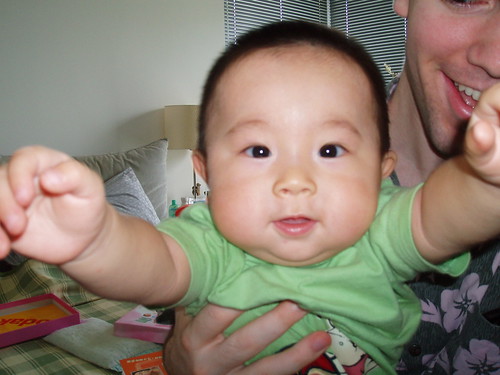H7N9
H7N9 is a serotype of the species Influenzavirus A (avian influenza virus or bird flu virus). H7 normally circulates amongst avian populations with some variants known to occasionally infect humans.
An H7N9 virus was first reported to have infected humans in 2013 in China.
On March 31, 2013, the Centre for Health Protection (CHP) of the Department of Health of Hong Kong received notification from the National Health and Family Planning Commission (the Commission) concerning three confirmed human cases of influenza A (H7N9).
On April 2, 2013, the CHP confirmed four more cases in Jiangsu province, all considered in critical condition in hospitals in Nanjing, Suzhou, and Wuxi. In a statement, the CHP said that no epidemiologic links had been found between the four patients and so far no other H7N9 infections have been identified in 167 of their close contacts.
The first reported death associated with H7N9 was an 87 year old man who died on March 4th. A second man, later identified as Wu Liangliang, aged 27, died on March 10th.
On April 3, 2013, Chinese authorities confirm that one man has died, thus bringing the number of deaths to three.
On April 4, 2013, the number of reported cases was 14, with 5 deaths. The two victims were a 48 year old man and a 52 year old woman, both from Shanghai.
On April 5, 2013, another person, a farmer, aged 64, living in Fuzhou (Zhejiang province), died, raising the death toll to 6. The Shanghai health ministry ordered culling of birds after pigeon samples collected at the Huhuai wholesale agricultural products market in Songjiang District of Shanghai showed H7N9. So far, more than 20,000 birds have been killed in a live poultry-trading area in Shanghai.
On April 6, 2013, all Shanghai live poultry markets closed temporarily in response to the H7N9 found in the pigeon samples. The same day, Hangzhou also closed its live poultry markets.
After gene sequence analysis, the national avian flu reference laboratory concluded that the strain of the H7N9 virus found on pigeons was highly congenic with those found on persons infected with H7N9 virus, the ministry said.
On April 6, 2013, the Chinese Ministry of Health reported 18 positive cases, death toll still at 6. Two days later, positive cases rose to 24 and one death case from Shanghai brought the death toll to 7.
On April 9, 2013, the National Health and Family Planning Commission announced "an additional three laboratory-confirmed cases of human infection with influenza A(H7N9) virus." The new patients "are two patients from Jiangsu – an 85-year-old man who became ill on 28 March 2013" and a "25-year-old pregnant woman who became ill on 30 March 2013" and " a 64-year-old man from Shanghai who became ill on 1 April 2013, and died on 7 April 2013". As of April 9, 2013, a "total of 24 cases have been laboratory confirmed with influenza A(H7N9) virus in China, including seven deaths, 14 severe cases and three mild cases."In Jiangsu, more than "600 close contacts of the confirmed cases are being closely monitored."
An update on April 11, 2013 on Xinhua lists the current totals as 38 identified cases and 10 deaths due to H7N9According to the WHO, of the 28 patients who have survived their infections so far, 19 illnesses were severe and 9 were mild. The WHO is also monitoring 760 close contacts and so far has no evidence of ongoing human-to-human transmission.
On April 13, a seven year old girl, from Beijing was the first confirmed case of H7N9 bird flu outside eastern China.
On April 14, Xinhua Chinese state media reports two human cases in central Henan just west of the area where the disease has been centered. 61 infected and 13 dead so far.The suspected path of transmission is from birds to humans. Moreover, Chinese officials also reported the first asymptomatic case in Beijing. A health department notice suggests that a 4-year-old boy had no clinical symptoms and was tested during surveillance of high-risk groups.
On April 17, a total of 77 cases have been confirmed, with 16 deaths so far. In Taiwan, authorities are about to forbid slaughtering poultry in traditional markets. That afternoon, Xinhua reports that the seven year old girl from Beijing (its first confirmed case) regained her health and is being discharged from the hospital.
On April 18, 83 cases are reported so far, the last being a poultry trader from Henan province. 17 people died.
As of 04:00PM, April 20 (GMT+8), there are 96 confirmed cases, of which 18 are fatal; 9 victims had recovered and were discharged from hospital. The next day, confirmed cases rose to 102, fatal cases to 20, and those who recovered to 12.
On April 22, Forbes counted 104 cases, 21 deaths, and quoted Chinese state media reporting $2.7 billion in poultry industry losses.
On April 23, 3 more cases were reported in an update from the WHO. All of the newly reported cases are in older men from eastern China. Two cases came from the Zhejiang province and the third was from the Anhui province. Total cases count reached 108 with 22 deaths.
On April 24, a case was confirmed by the Taiwanese Government, marking the first case of non-Chinese nationals.












No hay comentarios.:
Publicar un comentario